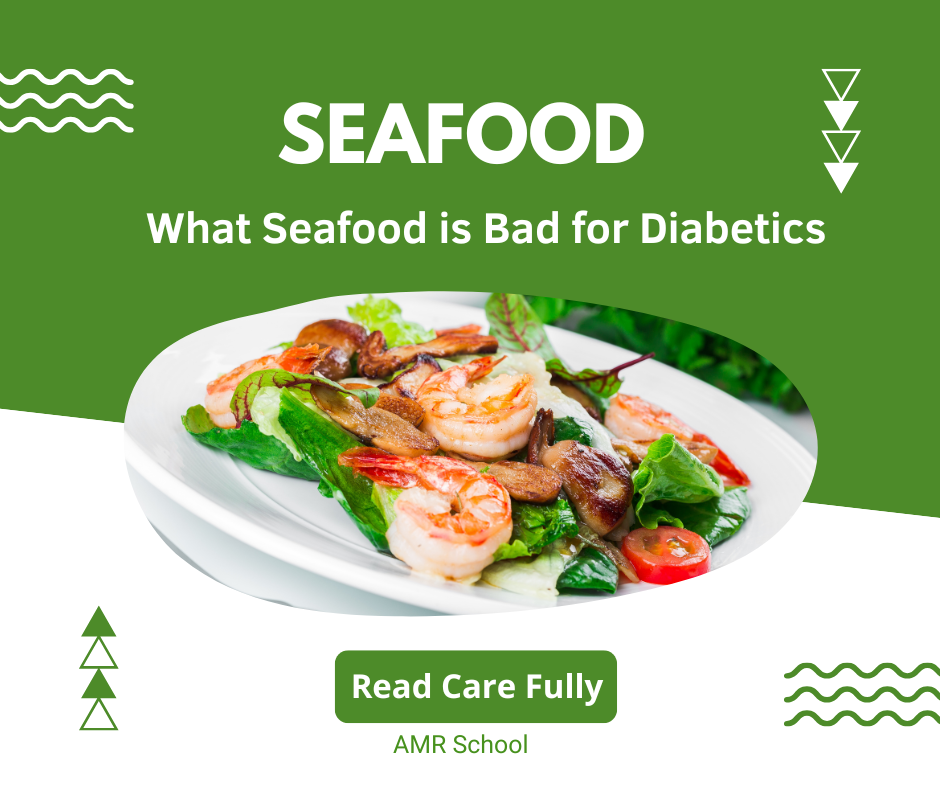
If you have diabetes, picking the right seafood can help you stay healthy. Some seafood is great for keeping blood sugar levels steady, but others might not be as good for you. Knowing which ones to eat and which to avoid is important.
Seafood can be a tasty and healthy way to manage your diabetes. Choosing the right options can help keep your blood sugar balanced and make meals more enjoyable.
Finding the best seafood for diabetes doesn’t have to be hard! In this guide, we’ll share how seafood affects your blood sugar and help you pick the best options for your health. Let’s make eating healthy simple and delicious!
Understanding the Relationship Between Seafood and Diabetes
If you have diabetes, seafood can be a great way to stay healthy. It’s packed with good stuff like protein and healthy fats, which help keep your blood sugar in control and give your body the nutrients it needs.
The trick is to pick the right seafood. Go for options like shrimp, cod, salmon, or tuna. These are low in bad fats and high in protein, which helps you stay healthy and manage your blood sugar better.
Adding seafood to your meals can be a simple and tasty way to support your health while enjoying delicious food!
How Seafood Affects Blood Sugar Levels
Seafood’s impact on blood sugar varies by type and how it’s prepared. For instance, fatty seafood like fried fish can raise blood sugar. But lean seafood, like grilled fish, can help keep it stable.
Protein and Fat in Diabetes Management
Protein and healthy fat are super important for people with diabetes. They help keep your blood sugar steady and give your body the good stuff it needs. Seafood is a great pick because it’s full of both. It’s tasty, healthy, and a smart choice for managing diabetes!
Benefits of Seafood in a Diabetic Diet
Seafood is a great food choice for people with diabetes! It helps keep your blood sugar in check, supports a healthy weight, and boosts your overall health. With so many tasty seafood options, it’s easy and fun to add them to your meals for a healthier lifestyle.
Bad Seafood for Diabetics
If you have diabetes, it’s important to know which seafood can raise your blood sugar. Some seafood has too much mercury, unhealthy fats, or added sugars, which are not good for people with diabetes. Here are some types of seafood to avoid:
- Shark and swordfish: These fish have a lot of mercury.
- King mackerel: This fish also has a lot of mercury.
- Tilefish: It has high mercury and unhealthy fats.
For a healthy diet, choose seafood that is low in mercury and bad fats. Always pick the best seafood for your health!
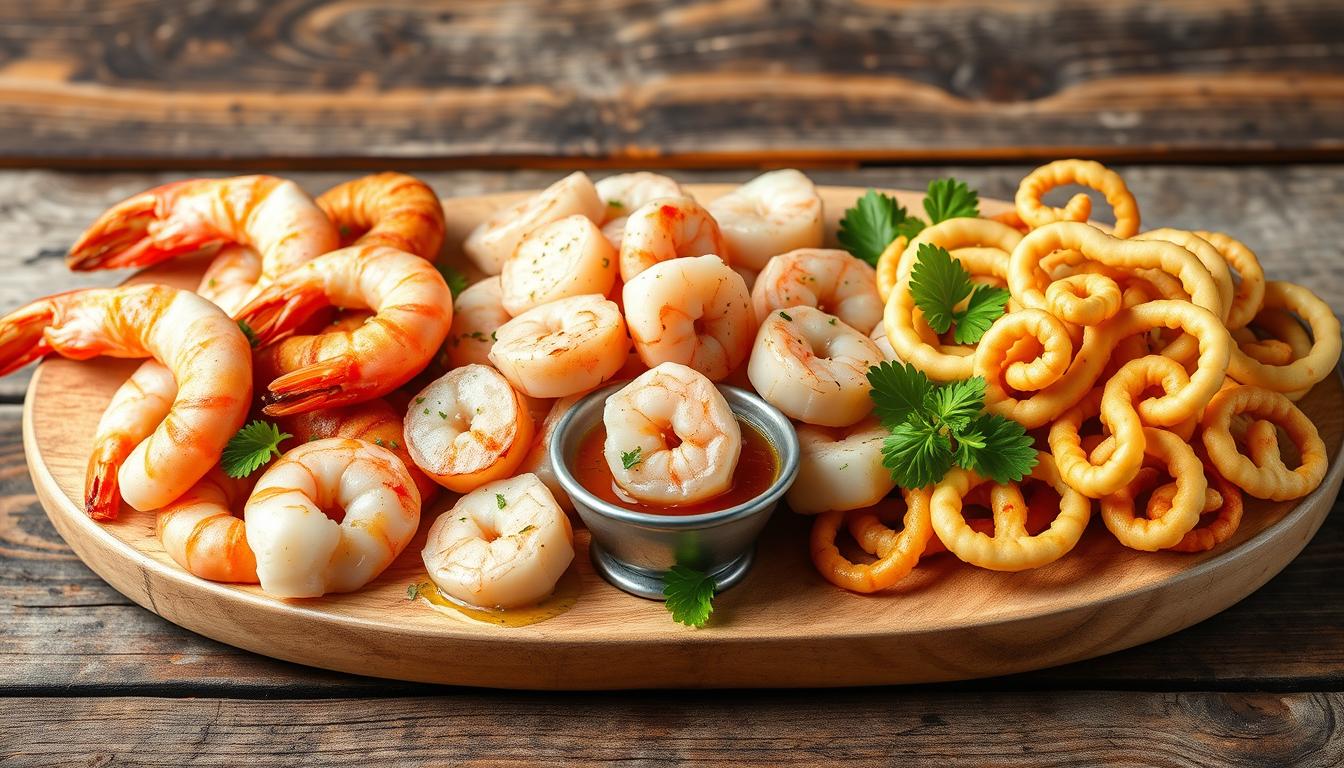
Breaded and Fried Seafood Concerns
If you have diabetes, be careful how your seafood is cooked. Fried seafood with extra breading has too much sugar, fat, and calories, which can make your blood sugar go up.
It’s better to bake or grill your seafood. These ways of cooking are healthier and help keep your blood sugar in control. Always choose healthier cooking methods for your meals!
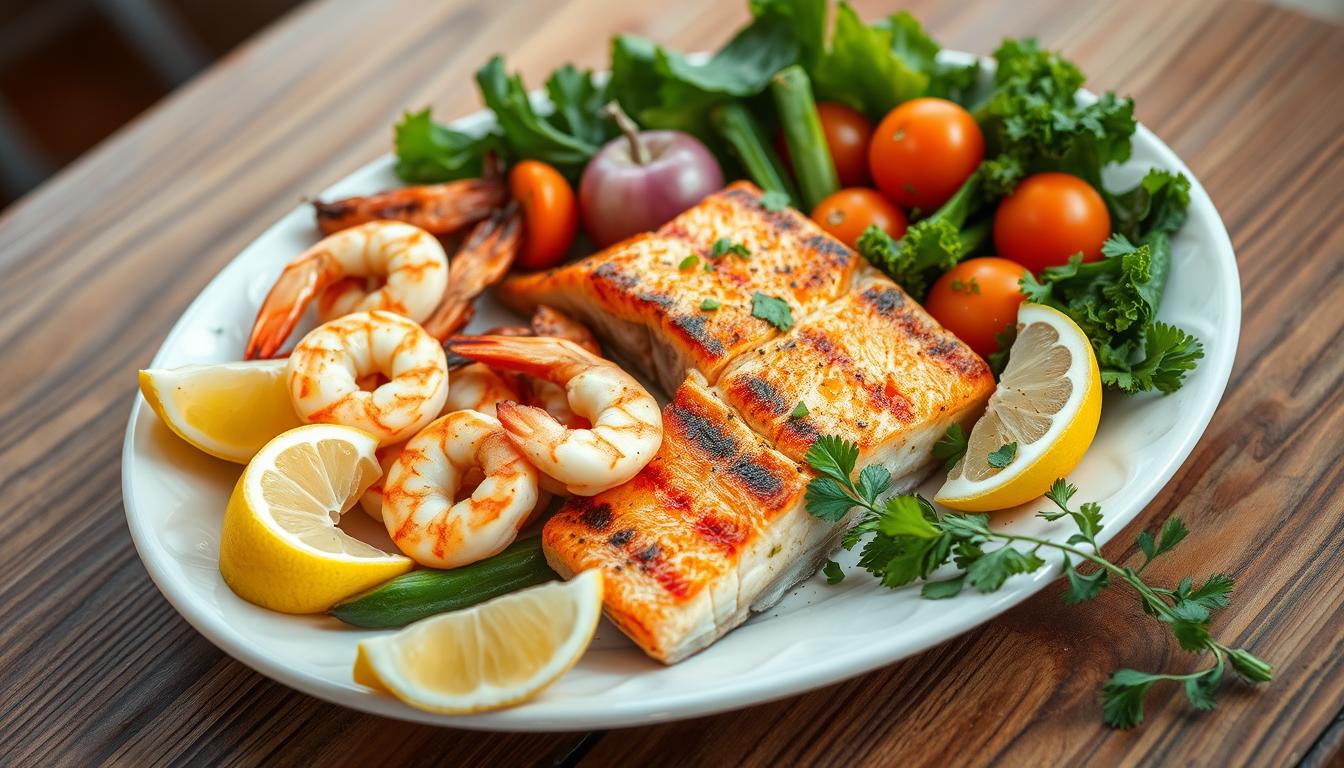
High-Mercury Seafood Considerations
Some seafood is not safe for people with diabetes. Shark and swordfish have too much mercury. Mercury can hurt your body, especially if you have diabetes.
To stay healthy, choose the right seafood. Fish like salmon, sardines, and anchovies are safe. They have good nutrients, like omega-3s, which help reduce swelling in the body.
Here’s how to pick good seafood:
- Choose fish like salmon, sardines, and anchovies.
- Eat different types of seafood to avoid too much mercury.
- Look at guides to check if seafood is safe.
By knowing which seafood is good, people with diabetes can enjoy it safely. Always ask your doctor or dietitian if you are unsure!
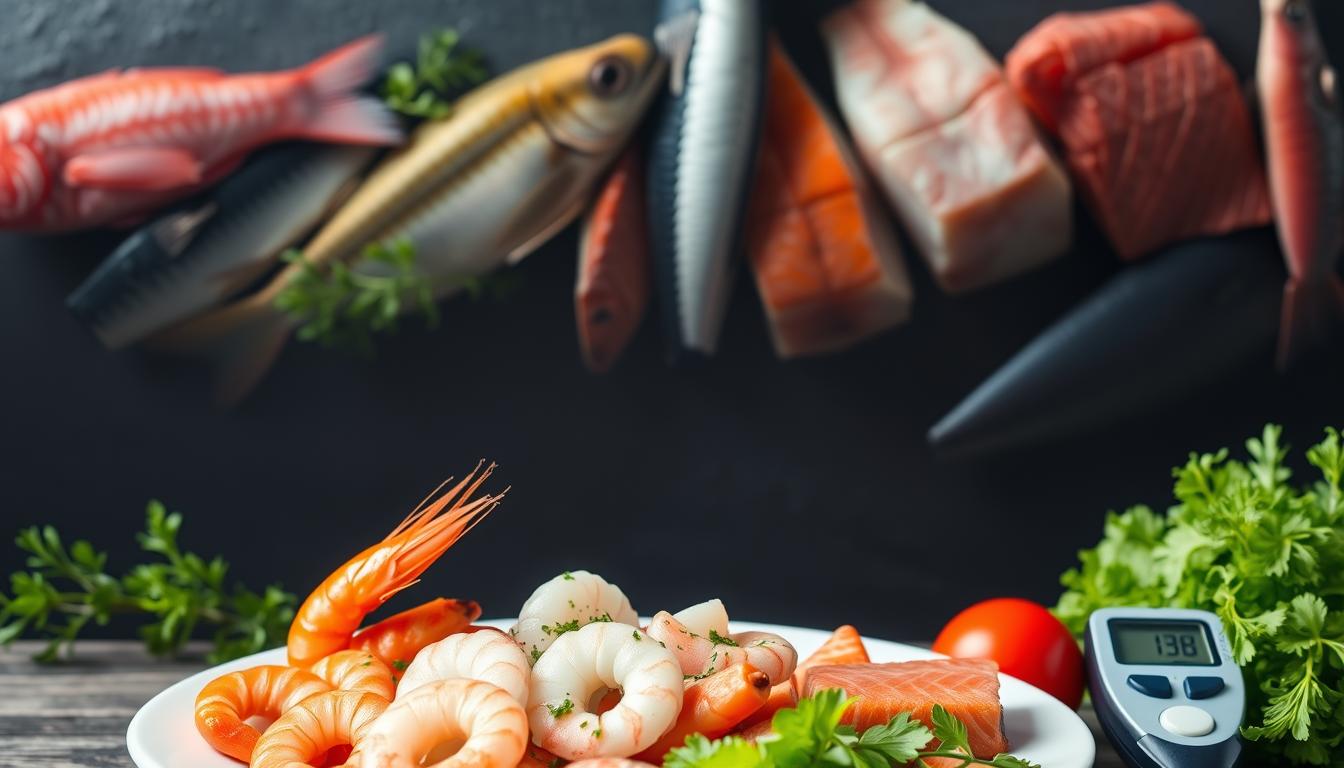
Processed Seafood Products to Skip
For people with diabetes, it’s important to avoid seafood with extra sugar, fat, and salt. Picking the right seafood helps you stay healthy.
Here are some types of processed seafood to avoid:
- Canned fish in sweet sauces can raise blood sugar.
- Pre-seasoned fish often have too much salt and sugar.
- Seafood salads with added sugar can make managing diabetes harder.
Choose seafood without extra sugar, fat, or salt to keep your blood sugar in check.
Canned Fish in Sugary Sauces
Diabetics should stay away from canned fish with sweet sauces because of the added sugar. A better choice is canned fish in water or olive oil.
Pre-seasoned Fish Products
Pre-seasoned fish can have a lot of sodium and sugars, not good for diabetics. Season fish with herbs and spices to control sodium and sugar.
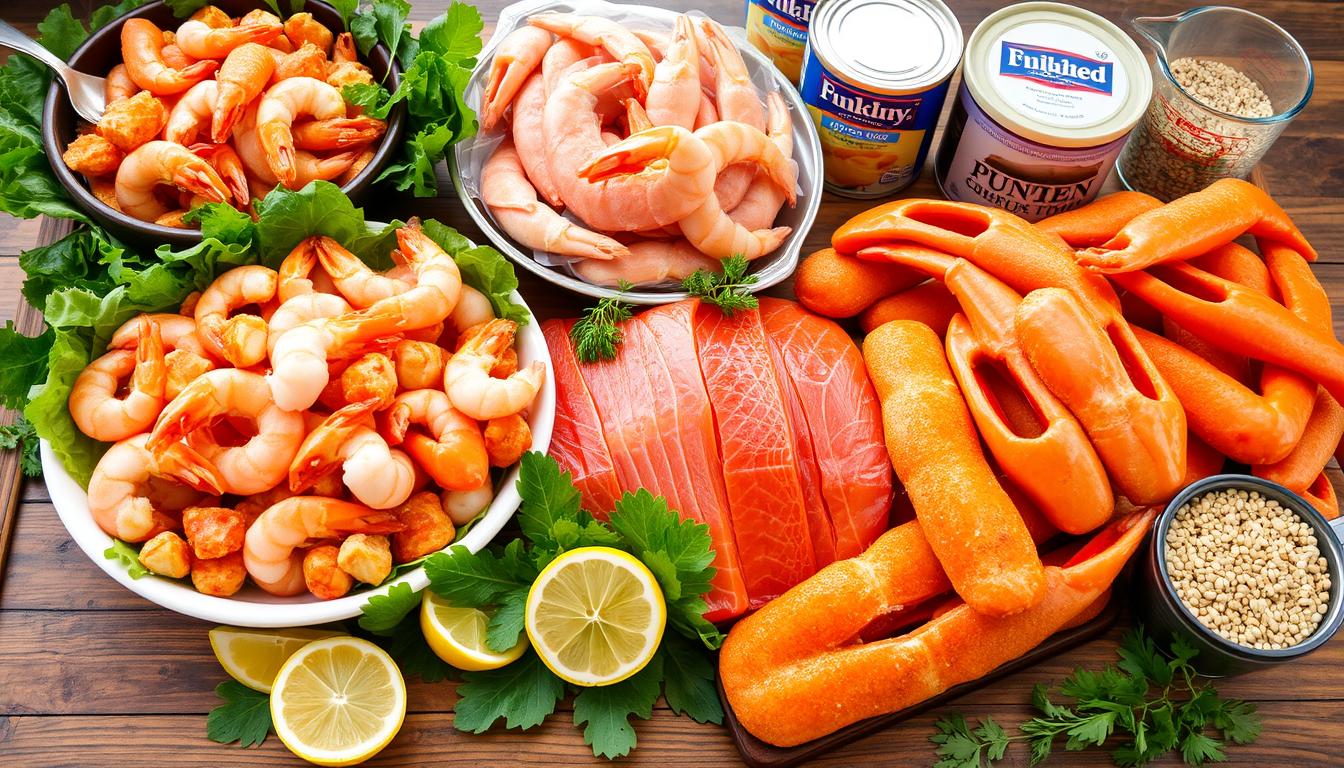
Seafood Salads with Added Sugars
Seafood salads can sometimes hide sugar. If you have diabetes, it’s best to pick salads with little sugar or even make your own with fresh, healthy ingredients. This way, you can enjoy your meal without worrying!
| Product | Sugar Content | Sodium Content |
|---|---|---|
| Canned Fish in Sugary Sauce | High | High |
| Pre-seasoned Fish Products | High | Very High |
| Seafood Salads with Added Sugars | High | High |
Impact of Preparation Methods
How seafood is prepared has a significant impact on whether it is suitable for diabetics. The nutrients in seafood are preserved when it is grilled or baked, so these methods are good alternatives. However, seafood and blood sugar levels can be elevated due to the addition of calories and fat while frying.
Here are some tips for preparing diabetes-friendly seafood:
- Grilling, baking, and poaching are low-fat options.
- Avoid salt and sugar in seafood recipes.
- Instead of adding salt or sugar, use herbs and spices to make food taste better.
By following these tips, you can enjoy tasty and healthy seafood. This won’t harm your seafood and blood sugar levels. Always check the nutrition label and talk to a healthcare professional or registered dietitian for advice.

Portion Control Guidelines for Diabetic Seafood
If you have diabetes, keeping your blood sugar steady is super important. Did you know seafood can help? Picking the right seafood can make a big difference.
The key is to mix it up! The American Diabetes Association says it’s smart to eat a variety of fish. This keeps your meals tasty and helps you stay healthy.
How Much Seafood Should You Eat?
A serving of seafood is about 3 ounces, which is the size of a deck of cards. Eating the right amount is important. It gives you the benefits without too much protein or fat, which helps control blood sugar.
How Often Should You Eat Seafood?
Eating seafood twice a week is a good rule. The American Heart Association says each serving should be about 3.5 ounces. This keeps it healthy and balanced.
Mixing Seafood with Other Proteins
Seafood is great, but it’s also good to eat other types of protein. You can try lean meats, chicken, or plant-based options. Mixing it up gives your body the nutrients it needs and keeps blood sugar steady.
By following these tips, you can enjoy seafood as part of a healthy diet. It’s a simple way to stay on track and take care of your body.
Best Practices for Seafood Selection
Picking the right seafood is important for people with diabetes. Here are some simple tips to make good choices and stay healthy.
What to Choose:
- Go for fish that are low in mercury, like sardines and salmon.
- Pick fresh, frozen, or canned seafood with no extra sugar or preservatives.
- Wild-caught fish is often a better option than farmed.
What to Avoid:
- Stay away from sharks and swordfish because they have a lot of mercury.
- Avoid breaded or fried seafood, as it adds extra fat and calories.
Quick Tips:
- Always read food labels to check for added sugars or chemicals.
- Try grilling, baking, or steaming seafood for healthier meals.
By following these tips, people with diabetes can enjoy seafood and keep their diet balanced.
Monitoring Blood Sugar After Seafood Meals
If you have diabetes, it’s important to keep your blood sugar steady, even after eating seafood. Some seafood can change your blood sugar more than others. Checking your blood sugar after eating helps you see how your body reacts. This lets you make better food or medicine choices to stay healthy and enjoy seafood.
When to Check Blood Sugar Levels
Check your blood sugar before meals and bedtime. This helps you see how your body reacts to food, like seafood. It’s a simple way to stay healthy and make better choices.
Signs of Adverse Reactions
If you feel dizzy, sick, or very tired after eating seafood, it might mean your blood sugar is too high or too low. Pay attention to these signs and check your blood sugar. If needed, change what you eat or your medicine.
By watching your blood sugar and knowing how your body feels, you can enjoy seafood and stay healthy, even with diabetes
Safe and Healthy Seafood Alternatives
If you have diabetes, picking the right seafood is important. Choose fish that are low in mercury and don’t have extra sugar. Good choices are cod, tilapia, and salmon.
Seafood can help keep your blood sugar steady and make you healthier. Here are some great options:
- Salmon has healthy fats.
- Scallops, mussels, and clams are safe and don’t have much sugar.
When cooking seafood, try grilling, baking, or steaming. These ways are healthier and don’t add bad fats or sugar.
By choosing wisely, you can enjoy seafood that’s tasty and good for you. Talk to your doctor or dietitian to learn more!
Shopping Tips for Diabetes-Friendly Seafood
Picking the right seafood is important for people with diabetes. Choose fish that is low in mercury and has no added sugar. This helps you stay healthy while enjoying seafood.
It’s a good idea to check labels before buying. Look for fish that says “low mercury” or “wild-caught.” Fresh seafood is great, and frozen seafood is fine too, but avoid ones with preservatives or sauces.
Here’s how to pick the best seafood:
- Pick wild-caught fish. It’s cleaner and safer.
- Don’t buy seafood with sugary sauces.
- If buying frozen fish, look for “flash frozen” to keep it fresh.
By following these tips, you can enjoy seafood that is tasty and good for diabetes.
Conclusion
Seafood can be great for people with diabetes if you pick and cook it the right way. It’s good to know how seafood can change your blood sugar. This helps you enjoy seafood while staying healthy.
Pay attention to how seafood affects your blood sugar. Always ask your doctor or health team for advice. With the right tips, seafood can be both yummy and healthy.
So, try different kinds of seafood! It’s a simple way to stay healthy while living with diabetes.
FAQ
What seafood is good for diabetics?
Fish like salmon, tuna, cod, tilapia, and shrimp are healthy choices. They are low in mercury, sugar, and unhealthy fats.
Does seafood affect blood sugar?
Yes, it can. Seafood has protein and healthy fats that help keep blood sugar steady. But fried or breaded seafood can raise blood sugar, so try to avoid those.
What seafood should diabetics avoid?
Avoid fish with a lot of mercury, like shark, swordfish, and tilefish. Also, stay away from fried or processed seafood.
How should diabetics cook seafood?
Bake, grill, or broil seafood to make it healthy. Don’t fry or bread it. Use herbs or spices instead of sweet sauces for flavor.
How much seafood should diabetics eat?
Diabetics can eat seafood 2–3 times a week. A serving should be about 3–4 ounces, like the size of a deck of cards.
What nutrients in seafood help diabetics?
Seafood has protein, healthy fats, and vitamins like vitamin D and magnesium that are good for managing diabetes.
How do diabetics shop for seafood?
Look for fresh or frozen fish that is wild-caught. Avoid fish with added sugar, salt, or unhealthy fats.
How can diabetics check their blood sugar after eating seafood?
Test your blood sugar before and after meals to see how seafood affects you. If it causes changes, talk to your doctor or adjust your meals.
Leave a Reply